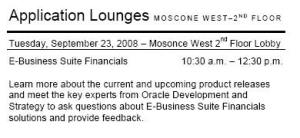Saturday, April 17, 2010
New Oracle Financials Blog
If you have any other blogs of interest or tweeters, please share them with all the readers in the comments below.
Sunday, November 16, 2008
FSAH and AGIS Intercompany Implementation thoughts
As Intercompany transactions are very likely to cross systems they are a good candidate for integration in a 'Hub' of some sort.
In R12 the Financials Services Accounting Hub (FSAH) allows integration of third party systems to Oracle and is incredibly powerful and flexible.
Let's use a simple example:
Company A and B both use two different Ledgers. A Sales Invoice is issued by Company A (to Company B) for $5,000
The accounting needs to be created as below, they need to be booked with the same accounting date in the same period.
In Company A
Debit Intercompany AR $5,000
Credit Intercompany sales $5,000
In Company B
Debit Expense or inventory (per content), $5,000
Credit Intercompany AP, $5,000
So there's a number of options that come to mind (in no particular order).
1) Using Oracle Accounting Hub you can account for transactions form third party systems, it uses the Subledger accounting engine to process accounting events defined for the third party system. If your invoice systems are third party applications, you could create 2 events (one for each company/ledger/party to the transaction) for the sales invoice and get the full accounting out of the single system integration.
2) Enter these transactions in AGIS, the specific accounting will be entered/generated and approvals from company A and B obtained before AGIS either books it direct to GL or generates the Invoice for company A and B if required.
3) It may not be ideal to force users to navigate to a different screen (or change some import process, EDI, XML feed etc) to issue Intercompany invoices from other invoices as in 2) above. So continue to enter in your regular sales invoice system but run a process which detects an invoice is Intercompany and cancels it, then generates a transaction for it in AGIS (via the Open Interfaces) or FSAH.
I don't think any one of these is right for all situations, detailed analysis of the particular implementation environment and requirements needs to be done to figure out the best approach. If you have any thoughts, better suggestions or experience then please share them in the comments.
Thursday, September 18, 2008
Financials Sessions at Oracle Open World 2008
My session is listed there, I look forward to seeing some of your there.
Thursday 25th, 3:00 p.m.
Moscone West 2006
Are Intercompany Processing and Reconciliation Currently Pain Points for Your Enterprise?
David Haimes, Oracle; Helle Hennings, Oracle
 I blogged last year about the meet the Experts Lounge, well this year it has been renamed to Applications Lounge. I haven't been asked to attend this year, so if you want to ask me any questions or provide feedback you'll have to come to the session above, find me at the DEMOgrounds, the Blogger Meetup or follow me in twitter, or use this blog all year round - remember customer interaction is not just for Oracle Open World, it's for life.
I blogged last year about the meet the Experts Lounge, well this year it has been renamed to Applications Lounge. I haven't been asked to attend this year, so if you want to ask me any questions or provide feedback you'll have to come to the session above, find me at the DEMOgrounds, the Blogger Meetup or follow me in twitter, or use this blog all year round - remember customer interaction is not just for Oracle Open World, it's for life.
Friday, August 15, 2008
Fixed Assests Intercompany in R12
 [/caption]
[/caption]Something I often forget to mention is the enhancement of Intercompany functionality in Fixed Assets (FA) that has been provided in R12. So here is my attempt to explain it, based on an old email discussion with the FA team, I wouldn't describe myslef as an FA expert, but if there are any comments or questions I might be able to find an FA expert to get an answer. :)
In 11i FA stores reference accounts in two setup entities; Book Controls and Categories. The intercompany Payables and Receivables accounts were stored directly on the book, only the natural accounts segment were stored for these two accounts. The Account Generator definition would combine the natural account with other sources to get a full account combination. Out of the box, those sources were a default ccid which is also on the book and a ccid from the asset assignment. So the balancing segment is derived from the asset assignment, the natural account from the values on the book, and other segments from the default account.
The intercompany would kick in for two transaction types "Transfer" and "Unit Adjustment". However, other transactions could result in intercompany impacts, but they would not be generated in FA so GL would do the balancing when the accounting was posted there.
So in R12 FA uses the AGIS Intercompany balancing feature, which is
Friday, July 18, 2008
Interesting R12 Upgrade Session at Open World
Sunday, July 13, 2008
Intercompany Session at Oracle Open World
There's an Intercompany session (
| Session ID: | |
Thursday, June 26, 2008
What is your functional currency?
 Regular readers will probably be used to this answer now... it depends.
Regular readers will probably be used to this answer now... it depends.In General Ledger 11i your functional currency referred to the currency of your set of books, it was one of your three Cs (Calendar, Currency and Chart of Accounts). In R12 we changed the terminlogy, there is no more set of books that is now renamed Ledger and the Currency of your Ledger is referred to as the Accounting Currency of the Ledger.
This is a subtle change and I'm sure experienced 11i practitioners are still using the term functional currency but you all need to stop because it's confusing people.
In Financial standards (IAS 21 and FAS 52), Functional Currency is a test
Friday, June 13, 2008
R12 Best Practices White Paper
Best Practices for Adopting Oracle E-Business Suite, Release 12 (Metalink Note 580299.1)
I haven't reviewed the document yet, despite there being a section on AGIS. As soon as I resolve the problem I'm having with my metalink login I will take a look. I understand it was pulled together by Anne Carlson, who I know reads this blog becasue she mailed me just today with a question about it, I'm hoping some of the useful posts from this blog made the cut.
I want to use this opportunity to plug two other guides that are new in R12 and I highly recommend you read if you are looking at upgrading to R12.
Oracle Financials Concepts Guide, Release 12 (Part No. B28873-01
Oracle Financials and Oracle Procurement Functional Upgrade Guide: Release 11i to Release 12 (Part No. B31543-01)
I discuss them a little more along with a few other resources in this post.
UPDATE (June 16th):
I reviewed the White Paper and the AGIS section is fairly sparse - I will be contacting the author to try and get more detail in there.
However on the whole I think it's a great document and essential reading for anyone looking to implement or upgrade to R12. Now if we can just publish that information on a blog, then we'll truly have a living document, I'll ask that question of the document owners.
Monday, May 12, 2008
Financial Services Accounting Hub (FSAH)
 Financial Services Accounting Hub or FSAH (pronounced F-saa apparently) is a great product and is not only for Financial Services companies either, I understand we'll sell it to anyone.
Financial Services Accounting Hub or FSAH (pronounced F-saa apparently) is a great product and is not only for Financial Services companies either, I understand we'll sell it to anyone.From a (very) high level perspective it allows you to use Oracle SLA and GL to perform the accounting for third party applications. Companies the Financial services industry tend to build a lot of highly complex applications (e.g. loan systems, trading systems) in house, but they want the final accounting of transactions form these disparate system to end up in the same place and it will be nice if they can re-use the same accounting rules too.
Monday, March 24, 2008
AGIS Out of the Box

When I was about 10 years old I got a new electric train set for Christmas, but before I got to play with it I had to pinch a plug from one of my siblings toys and fit the only available (and dangerously mismatched) fuse in it. Then I had to read a complicated set of instructions to assemble a delicate set of parts and it was a minor miracle that I had it working before the New Year.
Now when I buy something new, the first thing I do is open the box, turn it on and press buttons to work out how to use it, if I get stuck I maybe look to see if they have a quick start guide. Consumer goods manufacturers make things very intuitive and ready to work right out of the box these days and we have grown to expect that. Remember that iMac add? step 1: plug into power, step 2: plug into a phone line, step 3: - there is no step 3! Wow can I have an ERP system like that please?
When designing AGIS for R12 we tried to minimize the time it would take to get started entering transactions in an initiative we internally called 'AGIS out of the Box'. I have to give credit to this idea to my former bosses Joe and Terrance for initiating this, but the whole team stopped, sat down and thought about what we could do to allow users to open the box and start using AGIS right away.
We came up with a few ideas
1) No profile options
Monday, March 10, 2008
Multi-Org Access Control
 Multiple Organizations Access Control or MOAC (pronounced MOW-ACK) to use the seemingly obligatory acronym, is a powerful, yet simple to implement feature available in R12.
Multiple Organizations Access Control or MOAC (pronounced MOW-ACK) to use the seemingly obligatory acronym, is a powerful, yet simple to implement feature available in R12.Implementors spend a lot of time figuring out how to configure their Legal Entities, Ledgers and Operating Units. There are a number of options some restrictions, depending on what features you want to implement and where you are. See my earlier posts on Legal Entities and Operating Units for details on that. However it is worth remembering that change is the Status Quo (No, not the band of rocking all over the world fame - it's latin, look it up) and flexibility is important, what was the optimal way to organize your transaction processing yesterday may not be right today. Many companies are creating shared service centers to centralize processing of financial transactions and a single user may process transactions on behalf of many different Operating Units(OU).
So MOAC allows you to create a security group which can contain many operating units and assign that to the User's responsibility. All the forms
Monday, February 18, 2008
The Armchair Architect
The good news is there is a blogger to the rescue. Anne Wong is The Armchair Architect and she's starting to get SLA content up on her new blog. I'd like to claim some credit as I badgered her into starting the blog, hopefully she will get regular readership and positive feedback to keep her momentum and get all that knowledge from her head onto the web so we can all benefit.
Saturday, February 2, 2008
And General Ledger too
I am a little uncomfortable calling myself owner of products, we use this to mean that the product management team and development team report to you. However I don't own anything, I didn't buy the product (like customers) I don't own the source code (that would be the Oracle shareholders) I would say it is more like stewardship of the product. However the fact of the matter is, I am the one people come looking for when there is a problem!
Taking on General Ledger is a big deal, it's the oldest of the Oracle Apps and has a huge existing user base. Given the close integration of Intercompany and LE with GL it is a good fit to have all three I have a reasonable knowledge of the product and have worked with the development team a lot over the years. The development team I have inherited are very strong, so I'm looking forward to working with them. I'm also looking forward to getting my arms around the product and plan for Fusion.
The net result is I'm going to be very busy, but I am determined to keep the blogging going and I hope I will have some new insight into GL that I can share over the coming months.
Monday, January 28, 2008
Defining Intracompany Balancing Rules
In order to take advantage of the automatic Intercompany balancing during GL posting and SLA Accounting you first need to define the accounts you want us to use.
Intercompany and Intracompany Accounts in R12 are defined in two different Set Up Pages, the Intracompany Balancing Rules are what we had in 11i for Intercompany Accounts (confusing I know) - this is where you will find the rules you had in 11i of you are upgrading from 11i. If you don't want to take advantage of the Legal Entity Configurator product and define Legal Entities and map them to your accounting structure, you can still go ahead and use the intracompany rules. If you start to map your Legal Entities to Ledgers and/or Balancing Segment Values (BSV) then you will want to be sure you complete the job, so there is no ambiguity in your setup. Consider the example below
Monday, January 7, 2008
Why do I need another period ?
So, I ask again - Why do I want another period ?
Saturday, January 5, 2008
Useful Oracle Financials Resources
Oracle Documentation Set
The first place to start should be the collateral provided by development, there are two new guides introduced for R12 which I think are very good.
Monday, December 17, 2007
Legal Entity Configurator - Why?
 In Oracle Ebusiness Suite 11i, the Legal Entity is tied closely to a set of books and operating Unit, so your Legal Structure has to be defined in the way you set up your apps partitions (OU, Set of Books etc.). In R12 financials breaks away from that with the introduction of the Legal Entity Configurator allowing you to model your Legal Structure separately from the partitions in your ERP system. Then you mark certain items with an owning LE, rather than use the OU or set of books to derive the LE. So let's see what this buys you.
In Oracle Ebusiness Suite 11i, the Legal Entity is tied closely to a set of books and operating Unit, so your Legal Structure has to be defined in the way you set up your apps partitions (OU, Set of Books etc.). In R12 financials breaks away from that with the introduction of the Legal Entity Configurator allowing you to model your Legal Structure separately from the partitions in your ERP system. Then you mark certain items with an owning LE, rather than use the OU or set of books to derive the LE. So let's see what this buys you.
Monday, December 10, 2007
Can I assign an Operating Unit to Multiple Legal Entities?
 In R12, a new Legal Entity Configurator was introduced in financials and Legal Entities defined here are are assigned to Ledgers and/or Balancing Segments (Company Codes). However it is not possible to assign a Financials Legal Entity to an Operating Unit, you can only define a Default Legal Context (DLC) to an Operating Unit. This assignment can cause confusion as it is only possible to assign one DLC, but I can use more than one LE in that Operating Unit. The key word in DLC is default.
In R12, a new Legal Entity Configurator was introduced in financials and Legal Entities defined here are are assigned to Ledgers and/or Balancing Segments (Company Codes). However it is not possible to assign a Financials Legal Entity to an Operating Unit, you can only define a Default Legal Context (DLC) to an Operating Unit. This assignment can cause confusion as it is only possible to assign one DLC, but I can use more than one LE in that Operating Unit. The key word in DLC is default.



